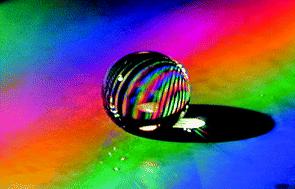 In the last two blogs, I reviewed the top ten most cited papers in Soft Matter. Now I want to move on to the most cited articles in Soft Matter of all time (well, since 2005 when the journal was founded).
In the last two blogs, I reviewed the top ten most cited papers in Soft Matter. Now I want to move on to the most cited articles in Soft Matter of all time (well, since 2005 when the journal was founded).
The top ten articles (as determined by ISI Web of Knowledge) are listed below. Their subject matter is diverse and ranges from why materials wrinkle and buckle, to the self-assembly of Janus particles, to a new experimental technique to measure the yield stress of fluids. However, despite this diversity, one topic clearly stands out in the top ten: superhydrophobicity. The top two spots are occupied by reviews on water repellency and superhydrophobic surfaces. Progress on superhydrophobic development by Roach, Shirtcliffe and Newton featured in an earlier blog and was also one of the most read articles in Soft Matter during 2010. A discussion on the measurement of contact angles also features in the top ten.
At number 1… On water repellency by Mathilde Callies and David Quéré is a review article looking at the physical mechanisms responsible for water repellency. It includes a discussion of switchable wettability and the dynamic properties of droplets on superhydrophobic surfaces. However, it is the questions that the authors pose, which are perhaps most interesting.
The authors start by stating that measurement of a single contact angle is not sufficient to characterise the wettability of a surface. A single contact angle does not give any information about how that droplet sits on the surface; is it the Cassie-Baxter or the Wenzel state? It also doesn’t provide any information on the ‘stickiness’ of the surface. To fully characterise a material contact angle hysteresis measurements must be carried out.
Quéré and Callies suggest that in addition to contact angle hysteresis, three complementary measurements should be made to answer the following questions: (1) What is the maximum radius a drop can have before it will roll off a surface inclined at a given angle? (2) What is the critical pressure required to change a droplet from being in the Cassie-Baxter state to being in the Wenzel state? (3) What is the threshold velocity, below which an impacting droplet will stick to the surface rather than bouncing off? The authors believe that this data would allow different surfaces to be more reliably compared.
The paper concludes with the statement that many questions remain unanswered regarding water repellent surfaces, in particular with respect to optimisation of the surfaces. The following are a selection of the questions that the authors pose: How does superhydrophobicity vary as a function of surface texture? How can we optimise a given material or design? Can special designs be used to get special properties? What is the maximum texture size/density required to promote water repellency? How can we make self-cleaning water repellent materials more robust?
On water repellency was published in the first issue of Soft Matter back in 2005. The citations show a huge development in the understanding of superhydrophobic surfaces over the last six years. There has been an explosion in the number of different water repellent surfaces and structures that can be fabricated. These include triangular polyimide pillars, hierarchical bio-fibres, chemically roughened aluminium, copper and zinc, structured teflon and silicone nanofilaments to name but a few. Surfaces have been designed allowing for tuneable adhesion of water (see for example Lai et al. and Di Mundo et al.). Yeh, Chen and Chang have studied how pillar size and spacing changes the wetting properties of the surface. They show that surface coverage and surface roughness strongly influence the hysteresis behaviour. Robustness of the surfaces has also been improved through material choice and pattern design.
With 220 citations to On water repellency I could keep going and going on the developments in the field. This selection shows that while a number of points raised by Quéré and Callies have been addressed (at least partially) over the last six years, some remain unanswered.
Top ten of all time:
- On water repellency. Callies M, Quéré D (2005). Citations: 220*.
- Progress in Superhydrophobic surface development. Roach P, Shirtcliffe NJ, Newton MI (2008). Citations: 211.
- Soft matter with hard skin. Genzer J, Groenewold J (2005). Citations: 134.
- Janus particles. Walther A, Muller AHE (2008). Citations: 130.
- Peptide based stimuli-responsive biomaterials. Mart RJ et al. Citations: 128.
- Surface-initiated polymerisations from silica nanoparticles. Radhakrishnan B, Ranjan R, Brittain WJ (2006). Citations: 94.
- Soft contact: measurement and interpretation of contact angles. Marmur A (2006). Citations: 94.
- Synthesis and applications of emulsion-templated porous materials. Zhang HF, Cooper AI (2005). Citations: 93.
- Bioinspired functional block copolymers. Borner HG, Schlaad H (2007). Citations: 92.
- Yield stress and thixotrophy: on the difficulty of measuring yield stress in practice. Moller PCF, Mewis J, Bonn D (2006). Citations: 87.
*Citation numbers taken on the 15th June 2011.










